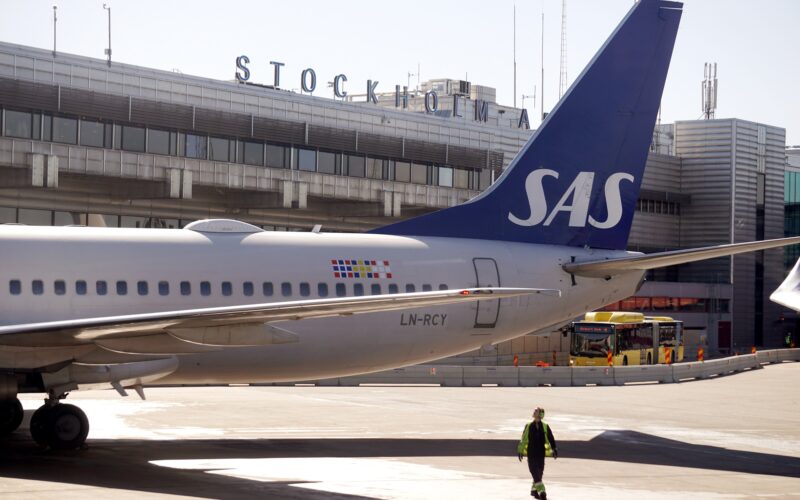When speaking to AeroTime at the World Aviation Festival 2023, Karin Gylin, the Head of Strategic Development and Innovation at Swedavia, which manages 10 airports across Sweden, shared that collaboration could be the key to unlocking the puzzle of sustainability within aviation.
Back in July 2023, Swedavia announced that it would be welcoming Heart Aerospace to test its ES-30 aircraft at Malmo Airport (MMX). The regional electric aircraft will be tested in terms of taxiing and charging procedures to verify the turnaround process. According to Gylin, this is “a natural step for [Swedavia]”.
“For several years now, we have been working to learn more and be prepared to welcome electrical aviation at our airports,” she added.
Gylin pointed out that, with MMX becoming the testing ground for the ES-30, it will be a great opportunity for Swedavia to test and see how taxiing and charging of electric aircraft works at an airport.
“It is an ecosystem that needs to work together. Swedavia [plays] a natural part in driving sustainable air travel,” the Swedavia executive said.
Swedavia’s representatives are also part of Heart Aerospace’s advisory board, which includes several airlines and seasoned aviation executives.
“[Collaboration] will be essential because we do not want to stop traveling. We want to stop emissions” Gylin explained. “Today, we do not fully know how to do that, so we need to innovate,” she continued, adding that nobody can do it alone. “No single player can achieve [zero-emissions].”
A balanced approach
Lawmakers are also stakeholders, which have an interest in reducing the emissions of aviation. Recently, the European Union (EU) finalized a Sustainable Aviation Fuel (SAF) mandate across the bloc’s airports, which will require fuel suppliers to provide at least 2% of SAF from 2025.
The percentage will progressively increase to 70% by 2050.
Gylin was not fazed by these new mandates, though, considering that Sweden already had implemented a mandate of its own in 2021. According to Fossil Free Sweden, the goal is to ensure that domestic flights within the country are fossil-free by 2030. By 2045, all domestic and foreign flights starting out from Sweden’s airports should be emissions-free.
In terms of an SAF mandate, since 2021 fuel suppliers have been required to provide 0.7% of SAF for the total fuel provision, with this mandate growing to 27% by 2030.
“We see it positively, because it will drive a clear path towards enabling more SAF production, getting more people onboard [the goals], and making SAF more widely available,” Gylin stated. At the same time, some executives from other companies speaking at the same event criticized the mandates, instead asking for incentives to accelerate SAF production.
Nevertheless, Gylin noted that “there are different ways” to encourage SAF production and “they need to be balanced”.
“The production is an important question [to address],” the Swedish executive said, adding that the industry needs to find ways of sustainably producing SAF. “It is an important question that needs to be solved,” she noted.
Gylin also said that Swedavia has been preparing for the mandates, purchasing SAF for Swedavia’s own business trips since 2016 and establishing an incentive program for airlines in 2017.
“We already have a purchasing system in place, and we also offer incentive programs for SAF for airlines,” she explained.
Technological solutions
There are also ways of reducing emissions by using technology.
“[Swedavia] has ways to optimize flight routes, conduct curved approaches, and we are working a lot at our airports to optimize the fuel consumption,” Gylin said. However, clean energy, which will be a “key element in the transition” to net zero, remains a concern.
“How can we produce clean energy and how can we manage it in a way that the infrastructure for clean energy is sufficient to handle the change?”
According to Gylin, this will require intelligent digital solutions.
She also described how Swedavia has been using technology to manage its energy usage, using real-time WiFi sensor data to manage the climate systems at ARN, redirecting energy to where it is most needed.
However, technology can also help passengers and improve their experience at the airport. Gylin mentioned that the country’s main airport, Stockholm Arlanda Airport (ARN), opened a new security check point at the start of the summer to ease passengers’ journey through the airport.
“We are also working on adding mobile self-service options for age validation for youth tickets at our regional airports, which will enable younger travelers to validate their ID by using the normal application that they would use for their bank accounts,” Gylin explained.
But the executive noted that all airports within Europe are united in endeavoring to ensure a smooth door-to-door travel experience. Achieving that goal will require collaboration between different modes of transport, including trains, buses, and ride-sharing services.
“We need to share data to collaborate,” she added, noting that “seamless intermodality is one of those issues that we are all trying to figure out in order to improve the passenger experience”.
This is particularly pertinent considering the chaos that ensued across Europe in the summer of 2022, which was a difficult pill to swallow for all European airports.
“It has been a very good summer [so far],” Gylin commented, adding that there are still new facilities set to come at ARN that can only improve the passenger experience.

